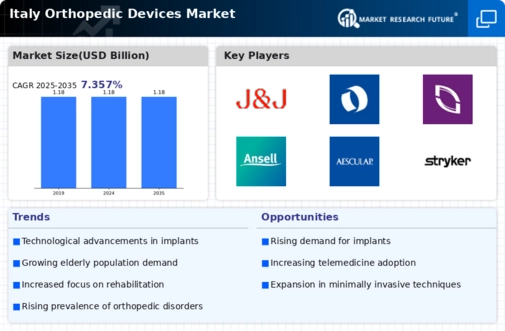Increased Healthcare Expenditure
Italy's rising healthcare expenditure is significantly impacting the orthopedic devices market. The government and private sectors are allocating more funds towards healthcare services, which includes the procurement of advanced orthopedic devices. In 2025, healthcare spending in Italy is projected to reach approximately €200 billion, with a notable portion directed towards orthopedic care. This financial commitment facilitates the adoption of cutting-edge technologies and devices, improving patient outcomes and satisfaction. Additionally, as healthcare budgets expand, hospitals and clinics are more inclined to invest in high-quality orthopedic devices, which could lead to a more competitive market environment. Consequently, the orthopedic devices market is likely to benefit from this increased investment, fostering innovation and enhancing the availability of effective treatment options for patients.
Demographic Shifts and Urbanization
Demographic shifts and urbanization in Italy are influencing the orthopedic devices market. The movement of populations towards urban areas is associated with lifestyle changes that can lead to an increase in musculoskeletal issues. Urban lifestyles often involve sedentary behavior and increased stress, contributing to conditions that require orthopedic intervention. Additionally, the aging population in urban centers is more susceptible to age-related musculoskeletal disorders, further driving demand for orthopedic devices. It is projected that by 2025, urban areas will account for over 70% of the population, intensifying the need for effective orthopedic solutions. This demographic trend suggests that the orthopedic devices market will continue to grow as healthcare providers adapt to the changing needs of urban populations, ensuring access to necessary treatments.
Technological Integration in Healthcare
Advanced technologies are transforming the orthopedic devices market in Italy. Innovations such as 3D printing, robotics, and telemedicine are enhancing the design, production, and delivery of orthopedic devices. For instance, 3D printing allows for the customization of implants and prosthetics, catering to individual patient needs, which is becoming increasingly popular in Italian hospitals. Moreover, robotic-assisted surgeries are improving precision and outcomes in orthopedic procedures, leading to shorter recovery times. As these technologies become more prevalent, the orthopedic devices market is likely to experience a surge in demand for high-tech solutions. The ongoing collaboration between technology firms and healthcare providers is expected to further drive this trend, making the orthopedic devices market more dynamic and responsive to patient needs.
Growing Awareness of Preventive Healthcare
The rising awareness of preventive healthcare among the Italian population is driving the orthopedic devices market. As individuals become more informed about the importance of maintaining musculoskeletal health, there is a growing demand for preventive solutions, such as braces and supports. This trend is reflected in the increasing sales of orthopedic devices designed for injury prevention and rehabilitation. In 2025, it is estimated that the preventive segment of the orthopedic devices market could account for nearly 25% of total sales, indicating a shift towards proactive healthcare measures. Furthermore, healthcare professionals are emphasizing the role of preventive care in reducing the incidence of severe musculoskeletal conditions, which may further stimulate market growth. Thus, the orthopedic devices market is poised to expand as more individuals seek preventive solutions to maintain their health.
Rising Incidence of Musculoskeletal Disorders
The increasing prevalence of musculoskeletal disorders in Italy is a primary driver for the orthopedic devices market. Conditions such as arthritis, osteoporosis, and sports-related injuries are becoming more common, affecting a significant portion of the population. According to recent health statistics, approximately 30% of adults in Italy experience some form of musculoskeletal pain, which necessitates the use of orthopedic devices for treatment and management. This growing patient base is likely to propel demand for innovative orthopedic solutions, including joint replacements and braces. Furthermore, the Italian healthcare system is adapting to these needs by investing in advanced orthopedic technologies, thereby enhancing the overall market landscape. As a result, the orthopedic devices market is expected to witness substantial growth, driven by the urgent need for effective treatment options for musculoskeletal disorders.


















Leave a Comment